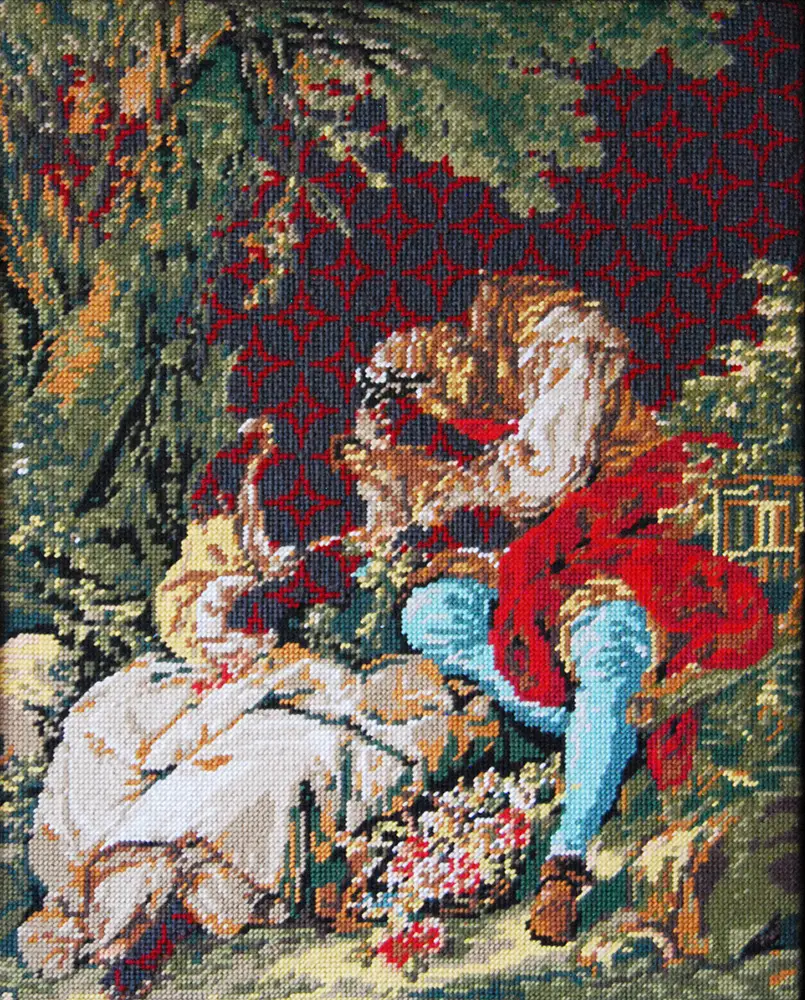
Welcome to Manbroidery, a series of interviews with male embroiderers. This month, Paul Yore.

Name: Paul Yore
Location: Sydney, Australia
Main embroidery medium: Wool/mixed media

Noteworthy projects or pieces:
Boys Gone Wild, Poetry, Dream and the Cosmos: The Heide Collection, Heide Museum of Contemporary Art 2013; EVERYTHING IS FUCKED, Like Mike, Linden Contemporary, 2013; WELCOME TO HELL, Primavera, Museum of Contemporary Art, 2014
How did you come to be an embroiderer?
For me, embroidery has been an extension of other craft methods like quilting and needlepoint. My beginnings were in needlepoint, which I taught myself slowly and rather randomly following a personal crisis in my life. It helped me to work through some stressful times.
What does it mean to you?
It’s meditation and therapy. It’s another world. Stitching things, sewing things, weaving, using fibres – these are really ancient processes. I believe there is a subversive element in choosing to work like this, to adopt these slow, laborious methodologies of image making in the computer age where everything is expected to happen instantly.

Where do you like to work?
One thing I like about stitching is it is very portable work. I work in my studio on large pieces but I also like to work in bed, sometimes watching trash on television or else listening to music. If the football is on, I’ll watch that and stitch.
How do people respond to you as a male embroiderer?
Well, because my work deals heavily with homoerotic themes and notions of queer identity, I guess the fact I use textiles is easy to dismiss, because needlecrafts are seen (erroneously) as a feminine thing, or a gay thing. For me, the fact I’m a man doing this doesn’t really enter into the equation. Men have stitched and sewn and woven for centuries, soldiers and sailors and tradesmen and tailors.
Who inspires you?
Leigh Bowery, Mike Brown, Henry Darger, Ginger Riley Munduwalawala, Hieronymous Bosch, Cher, heaps of people!

How or where did you learn you learn how to stitch or sew?
I taught myself the needlepoint technique through experimentation but my first exposure to this way of making was when I worked in a nursing home for the elderly. The walls were decorated with the various eclectic productions of the residents at the home. Most pieces I saw there were the pre-printed designs that you stitch “by number”, but I think those are fabulous in their own right – kitchy, banal subjects like idyllic landscapes sometimes in psychedelic colours. Seeing these works everyday for three years definitely informed my taking up the needle.
Are your current images new ones or have you used them before?
There are motifs that I will return to over and over – certain symbols or images that reoccur in my work like mushrooms, pineapples, phalli and skulls. Other images are new – I’m constantly incorporating new images.
How has your life shaped or influenced your work?
I think all artists are inseparable from their work in a sense; all art can be partly understood through the lens of the biographical.
What are or were some of the strongest currents from your influences you had to absorb before you understood your own work?
I am constantly re-looking and rethinking about what I’m doing and why I’m doing it. For me, the biggest challenge in my work is to view it in relation to the question of Australian history and the notion of identity in a colonial context. Australia is a deeply divided place, still wounded by invasion and colonial violence.

Do formal concerns, such as perspective and art history, interest you?
Absolutely. In many respects classical aesthetics has informed my work more than contemporary conventions. I have researched medieval Tapestry production and am really interested in the way figures ‘sit’ within the picture plane in these works. I also like ancient Egyptian art for this same reason, everything is highly stylized and flattened, but this creates a new type of space.
What do your choice of images mean to you?
I choose images that have a resonance with the concerns I am addressing in my work, although at times there is no rational explanation for what I depict; I like juxtaposing random things and creating new worlds of meaning. Sometime I choose things simply because they work formally.
Do you look at your work with an eye toward it like what can and can’t be visually quoted? In other words what you will or won’t cut out?
I’m not really concerned with that. If I like it, I put it in. It might be a quote from a Paris Hilton song, or a figure drawn from Grecian statuary; I sometimes draw figures from gay porn. For me, everything becomes newly available and open for question in an art context, even though people are still scared of art – I think it is a safe space to address difficult questions.

Do you have any secrets in your work you will tell us?
All my secrets are there in my work, if you look hard enough…
How do you hope history treats your work?
It will probably get burnt for fuel when all the coal runs out!
Where can we find you and your work?
Manbroidery was created with the support and wisdom of the magnificent Bascom Hogue.
Are you a manbroiderer with worthwhile work to share? Do you know a man who stitches and ought to be featured in this column?
Get in touch with us and we’ll and you to the growing ranks of marvellous manbroiderers!






